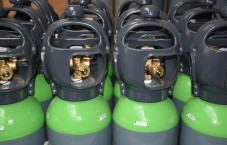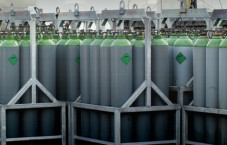TIG welding

Process
TIG welding stands for Tungsten Inert Gas. With TIG welding we use an inert gas. The technology works with a non-melting electrode. This consists of tungsten, to which some small quantities of thorium, cerium or other substances are added to improve the quality of the welding arc. Welding added material is inserted separately, manually, into the molten pool.
Non-alloy, low-alloy, corrosion-resistant and heat resistant steel sorts are welded with DC current. The metals which are covered with a layer of oxide such as aluminium and its alloys, are welded with AC current. This alternating current is necessary in order to ensure that the protective oxide layer of the object is 'beamed away'. The disadvantage is that the tungsten electrode becomes hotter because of this and partly melts, because of which this gets a rounded point and a less narrow weld is possible than with direct current welding with a sharpened electrode point.
Requirements
Protective gas
With TIG welding, the noble gas Argon is almost exclusively used as protective gas. Sometimes one welds with Helium or a gas mixture of Argon and Helium because that requires a higher arc voltage and therefore gives a deeper burn. Helium is more expensive and the required delivery rate is approximately double that of Argon. Sometimes a small percentage of hydrogen is added in the Argon because this lowers the surface tension of the molten pool and thereby gives smoother welds.
Welding equipment
TIG welding systems are available in various different versions, adapted to the application and the nature of the works. IJsfabriek Strombeek offers a wide range of TIG welding sets.
Advantages
- Very high weld quality. The risk of faulty-containment is virtually zero and the welder has an excellent view to the molten pool.
- Because the addition of material is done manually and is independently of the plasma arc, the adding speed can be determined completely independently.
- Welds without additions by melting of two parts of the workpiece to each other is perfectly possible.
- TIG welding is a very clean welding process: there’s no splashing and there is almost no welding smoke developed.
- One can weld in all positions.
- All fusible metals can be welded with this process, thus an ideal welding process for aluminium and magnesium.
- Ideal for thin material.
IJsfabriek Strombeek has in its range both argon, helium and hydrogen in pure form, as well as the various combinations of gas mixtures in all kinds of bottle sizes.
We can also offer the full range of welding equipment for TIG welding of leading brands such as Lincoln Electric, Esab and Parweld. In addition to the TIG welding sets, you can also come to us for all wearing parts whether or not compatible with Binzel-torches.
Delivery forms


